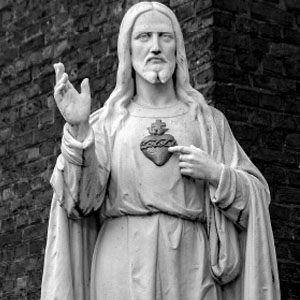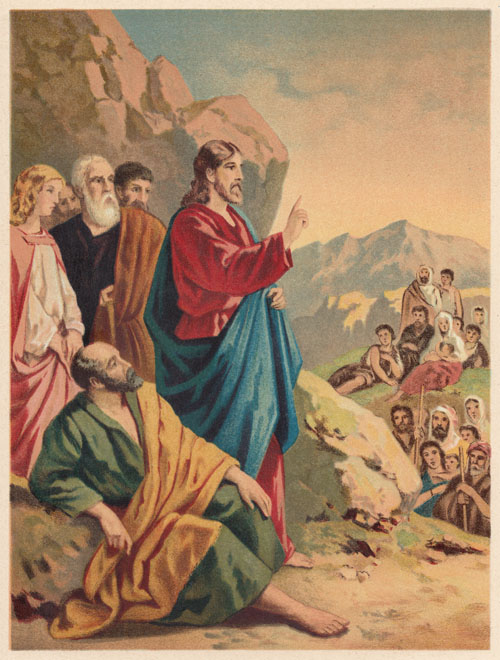Perspective: A Jewish American’s Transformation of His Perception of Jesus

Many Jews have seen the Christ through the filter of the havoc his followers have wrecked throughout history—such as the Crusades, slavery, Colonialism, and the Holocaust. It took exposure to Hinduism, and in particular Vedantic spiritual influences, for this author to see Jesus in a different light—as a mystic and a satguru whose teachings can be a legitimate pathway to the one, ultimate, unified Consciousness—Brahman.
Growing up in the melting pot of Brooklyn, long before it was a hipster enclave, I was familiar with three kinds of Jesus. There was the one-and-only begotten son of God, Savior of all Mankind, who was worshipped by the Irish and Italian Catholics in my working-class neighborhood. The other two versions were the ones prevalent amongst the Jews. One was the laudable ethical teacher—a nice Jewish boy, essentially a good rabbi who met with a terrible fate. The other, the favorite of the more cynical Jews, was a Jesus that never really existed—a creature of mythology, like Apollo or Zeus.
In my atheistic home, where religion was considered the opium of the people, Jesus was largely irrelevant, except as a proponent of the Golden Rule and for the horrors that had been perpetrated in his name, from the Crusades to slavery to colonial conquest and onward, up to and including complicity in the Holocaust (memory of which was still fresh for my elders).
Then came the Sixties, and I was introduced to a different Jesus, by way of India. Like many of my contemporaries, my hot pursuit of truth and personal fulfillment led me to the spiritual treasures of the East. I dove into the sacred texts of Hinduism and Buddhism, as well as its leading Western interpreters such as Aldous Huxley, Alan Watts, Joseph Campbell, and Huston Smith. The fiction of Herman Hesse and J.D. Salinger, whose characters were spiritual seekers who had turned toward the East, also played their part.
I was drawn to what was called mysticism because I found it, ironically, non-mysterious and eminently rational. I found a yoga class—not easy to do back then, believe it or not—and learned to meditate.
Throughout my explorations in Eastern spirituality, the subject of Jesus came up often, always in a highly respectful context. Because of my background, I found this both disturbing and confusing. Why did swamis and gurus have such reverence for a rabbi who died in the Holy Land two thousand years ago and whose followers have wreaked such havoc in the world?
This newly discovered perspective peaked when I read Paramahansa Yogananda’s seminal memoir, Autobiography of a Yogi. In it—and even more so in other works, as I discovered when I researched my biography of him—Yogananda treats the rabbi of Nazareth with such veneration that I couldn’t help thinking: What have I been missing?
So I bought a Bible and read the New Testament for the first time. It blew my young, impressionable mind. Because my spiritual reference point was already far more Hindu than Judeo-Christian, the Gospels came off the page like the Upanishads or the Bhagavad Gita—rather than the Christian dogma that Yogananda had chidingly called “Churchianity.”
I saw the main character, the one who came to be called Christ, as a master teacher. He was a satguru teaching his devotees not only how to behave but also how to turn within and realize theironeness with the divine. He was a yogacharya speaking to neophyte yogis. His term for Ultimate Reality was “Father” (according to the common English translations), but it was easy for me to evoke the language of the rishis, and substitute “Father” with “Brahman,” or “Ishvara,” or the Upanishadic “Self.” When Jesus tells the crowd at the Sermon on the Mount not to pray loudly and conspicuously like the hypocrites, but to “go into your room and shut the door and pray to your Father who is in secret,” I saw a guru directing his disciples to meditate in silence. It was not a major leap to imagine him looking one of them in the eye and saying, “Tat twam asi.” (“Thou art that”—the Vedantic Mahavakya illuminating the relationship between the individual and the Absolute.)
This was a Jesus I could live with: a holy man who is exalted in a way that befits someone whose impact on history has been unparalleled, but without the cosmos-shaking agenda or the Son of God triumphalism that relegates non-believers to irrelevance, eternal damnation, or heinous abuse.
I later learned that Hindus in general, and virtually all the teachers who came to the West from India, tended to see Jesus in much the same way—as an enlightened saint of the highest order. Some even placed him on the same level as Krishna and Rama in the pantheon of divine incarnations. In the Vedantic spirit of many paths leading to the same mountaintop, it was understood that the teachings of Christ, if followed to their ultimate depths, can be a legitimate pathway to the unified consciousness that is yoga’s true aim—a point made explicitly by Sri Ramakrishna based on his own experiments with a Christianized sadhana. That’s why I was not surprised to discover, subsequently, images of Jesus in the ashrams, temples, and meditation halls of some of the leading sampradayas (“spiritual lineages”). The centers in Yogananda’s lineage, in fact, display a portrait of Jesus on their altars, alongside those of Krishna, Yogananda, and the three venerated gurus in his parampara.
In fact, this way of seeing Jesus has been filtering into America’s bloodstream ever since the mid-19th century, when Ralph Waldo Emerson reconceived his ancestral religion largely as a result of reading India’s sacred texts, and Henry David Thoreau equated Jesus with Buddha and called himself a yogi. It gathered steam as a stately parade of gurus, beginning with Swami Vivekananda in 1893, arrived on our shores, and it exploded after the Beatles’ 1968 sojourn in Rishikesh with Maharishi Mahesh Yogi. By now it has affected millions.
For a great many Christians, who were alienated from, or angry with their religion, this alternative vision of Christ has been the key to reconnecting with their religious heritage on terms they can live with.

And many Christians whose spiritual orientation has been primarily influenced by Hindu teachings have been encouraged by various gurus to honor their Christian roots, often by thinking of Jesus as their Ishta Devata (preferred form of God). They may identify more with Christian mystics such as Meister Eckhart, John of the Cross, or Thomas Merton than with mainstream Christianity, but they find their way back to the Jesus they’ve always loved by way of India. Similarly, thousands of Jews who study Hinduism or Buddhism come to see Jesus as a mystical rabbi and a passionate reformer, not as the founder of a hostile cult.
The image of Jesus as a sage and guru may not sit well with clerics for whom Christ can only be the one true messiah and the great hinge of history. They ought to be glad that millions who might otherwise view the Christmas season as merely a respite from work, or as unadulterated humbug, will instead celebrate the birthday of a great guru. That’s what I’ll be doing. Each December it makes the season merrier, jollier, and brighter.
Philip Goldberg is the author of numerous books, including: the award-winning American Veda; The Life of Yogananda, a biography; and his latest, Spiritual Practice for Crazy Times. He cohosts the Spirit Matters podcast, blogs at Spirituality & Health, and leads American Veda Tours to India. He can be contacted through his website, www.philipgoldberg.com. To comment on this article, please write to letters@khabar.com.
Enjoyed reading Khabar magazine? Subscribe to Khabar and get a full digital copy of this Indian-American community magazine.
blog comments powered by Disqus












